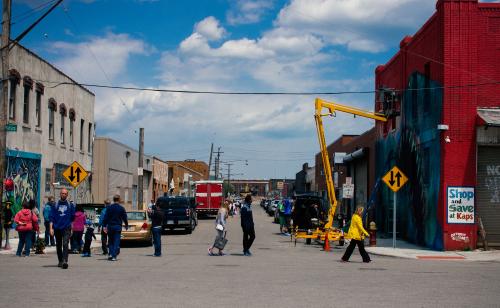Americans don’t move as much as they used to, even though people in some parts of the country fare better than others. Large metropolitan areas have stronger job growth and contribute more to GDP than small towns and rural areas. Urban residents have better health outcomes and life expectancy. Yet people are more reluctant to move to another town, state, or region. In particular, urban and rural residents are increasingly distrustful of one another. Popular culture is one channel through which Americans might develop negative expectations of other places. Small town residents whose experience of cities is based on Law and Order and The Wire could be forgiven for believing that large cities are crime-ridden drug havens. Sitcoms like Everyone Loves Raymond could give city-dwellers the impression that suburban demographics and lifestyles haven’t evolved much since Leave it to Beaver.
In this blog, I examine how the geography of TV has changed over time. Analyzing a sample of 135 scripted TV shows that aired between 1950 and 2017, I document shifts across urban-suburban-rural locations and across regions of the country.[i]
TV writers like real cities, fictional small towns, and outer space.
Slightly under half of scripted TV shows that aired between 1950 and today are set in central city locations (Table 1). Roughly similar numbers of shows are set in suburban locations (i.e. within metropolitan areas, but not in central cities) and in small towns or rural areas. A handful of shows take place in both urban and suburban locations, often with “home” scenes set in the suburbs and “work” scenes set in the city (i.e. Mad Men, Dick Van Dyke Show, I Love Lucy). About 15 percent take place in locations without a clear urban status, include non-U.S. settings (i.e. M*A*S*H), outer space (i.e. Star Trek), unspecified locations (i.e. Lost, Gilligan’s Island), or shows with no fixed location (i.e. Alfred Hitchcock Presents, Twilight Zone).

Almost all urban shows and about 78 percent of suburban shows are set in real, identifiable U.S. metropolitan areas. By contrast, more than half of small town and rural shows are set in fictional locations, including older programs such as the Andy Griffith Show and Petticoat Junction, as well as more contemporary shows like Friday Night Lights and Parks and Recreation. Nearly all small town or rural shows with real settings are Westerns (Gunsmoke, Deadwood, Bonanza). About 45 percent of shows with indeterminate urban status also have fictional locations. This category includes many science fiction or fantasy shows, for which settings often have no real equivalent (i.e. outer space).
Cities have become more popular on TV. The South has not.
TV shows have become consistently more urban over time, while the popularity of suburban and small town settings has fluctuated (Figure 1). In the 1950s and 1960s, fewer than 30 percent of shows were set in central cities. These included crime dramas such as Dragnet and Perry Mason, superhero shows like Superman and Batman, and comedies such as the Honeymooners. The urban share increased to about half in the 1970s and 1980s, then to around 60 percent by the 2000s. Suburban shows occupied about one-quarter of TV real estate from the 1960s through the 1990s. Over one-third of shows in 1950 were set in small towns or rural areas, mostly Westerns and comedies. The rural/small town share declined steadily through the 2000s, but made a comeback in the 2010s, with shows such as Justified.

While the urban status has changed substantially, the geographic representation by region has remained fairly consistent over time. In every decade, more shows have been set in the Northeast and West census regions than their overall population shares (Figure 2). About 15 percent of TV shows have been set in both New York City and Los Angeles, although each city contained on average four percent of the country’s population over this time period. Slightly fewer shows have been set in the Midwest than its population share, while the South has represented a much smaller share of TV shows (15 percent) than population (33 percent). The South’s share of scripted TV shows has grown only slightly since the 1950s, while population share has increased substantially. Moreover, 40 percent of Southern TV shows were set in the Baltimore or Washington, D.C. metropolitan areas, which are part of the South geographically but culturally more aligned with the Northeast. Texas and Miami account for a plurality of the remaining Southern shows.

Cities and small towns are dramatic. Suburbs are less funny than they used to be.
Whether geographic areas appear on TV is one thing; how a place is portrayed is another concern. One simple approach is to classify shows as either comedies or dramas. This is particularly relevant in considering whether a TV show presents particular places as welcoming or frightening.
Dramas make up a slight majority of the sampled TV shows since the 1950s, but this figure masks significant geographic variation (Table 2). Nearly three-fourths of suburban TV shows are comedies, and most of those are based around family relationships. These include 1950s and 1960s classics such as Father Knows Best and My Three Sons, 1980s shows like Family Ties and Roseanne, to current programs like Modern Family. While the share of dramas set in cities and small towns doesn’t show a consistent pattern over time, suburban shows have evolved toward dramas. In the 1950s, every show set in the suburbs was a comedy. Since the 1990s, almost half of suburban shows have been dramas (The Sopranos, My So-Called Life).

The Northeast and Midwest regions are portrayed as more comedic than the South and West. The Northeast’s comedy share is heavily influenced by New York City’s rich sitcom history, including I Love Lucy, The Jeffersons, Seinfeld, Friends, and 30 Rock. More than two-thirds of Midwestern shows are comedies, distributed across the region’s cities and suburbs (Mary Tyler Moore in Minneapolis, Roseanne in the Chicago suburbs, Home Improvement in the Detroit suburbs). Most Midwestern dramas are set in Chicago, plus Fargo and a few Westerns.
Nearly 60 percent of shows set in sunny Los Angeles are dramas, mostly crime and police procedurals. Even excluding Los Angeles, shows set in the West lean more heavily towards drama, from Twin Peaks to Buffy the Vampire Slayer to Grey’s Anatomy. As previously noted, Baltimore and Washington, D.C., account for many shows in the South; these tend to be crime or political dramas (Homicide, The Wire, West Wing, Homeland). Southern comedies are mostly set outside these two metro areas (Andy Griffith, Golden Girls, I Dream of Jeannie).
Why does geography on the small screen not match real life? And does it matter?
Why is the geography of TV so poorly aligned with where people live? (As well as unreflective of gender, race, and physical appearance, of course.) Entertainment is a business, and the producers of TV shows presumably want to maximize their potential audience. The results of this analysis raise several questions for further thought. Why do writers and producers invent fictional locations for small towns, when they use real metro areas for urban and suburban shows? Are they not acquainted with small towns, are the real ones not telegenic enough, or are there privacy concerns with small places? Why is the South so underrepresented among scripted shows? The region is home to 37 percent of nation’s people, most of whom don’t live in the Baltimore-DC corridor, yet barely registers among scripted shows. Reality TV has embraced all corners of the South, indicating demand for shows set in these locations.
Geographic bias in popular culture likely reflects—and contributes to—America’s continued polarization along political, cultural, and social lines. The gaps between where Americans live on TV and in reality suggest why Southerners, Heartlanders, and small town residents might feel overlooked by Hollywood and the Acela corridor. TV and movies should more accurately reflect America’s population along many dimensions, including geographic diversity.
Thanks to Cecile Murray for excellent research assistance.
[i] Searches were conducted for shows with the highest viewership by decade. The Writers Guild of America publishes a list of the 101 “best” shows. Although this is by no means a comprehensive inventory of shows, including shows based on popular and critical rankings captures shows that are most likely to shape public perceptions. Reality shows, variety/sketch shows, sports and news are not included in the analysis.
The Brookings Institution is committed to quality, independence, and impact.
We are supported by a diverse array of funders. In line with our values and policies, each Brookings publication represents the sole views of its author(s).







Commentary
Does TV bear some responsibility for hard feelings between urban America and small town America?
February 12, 2018